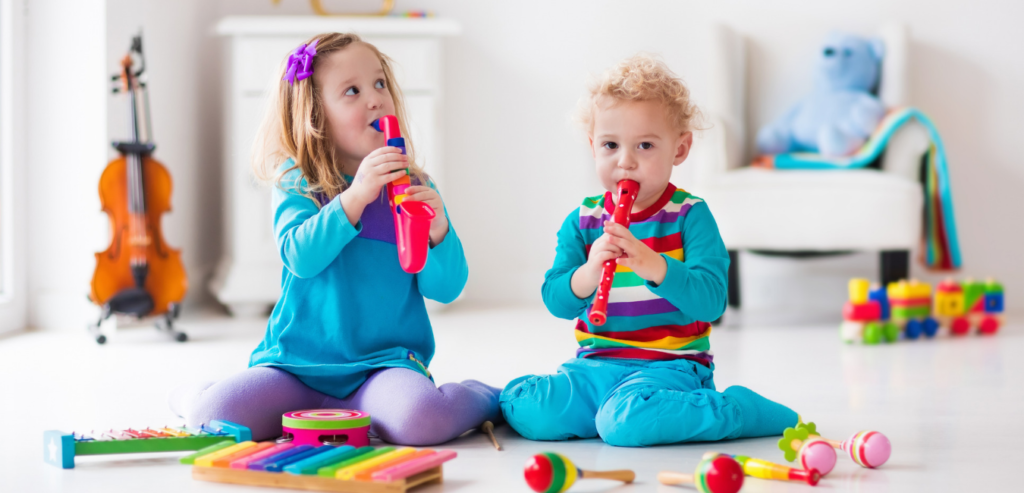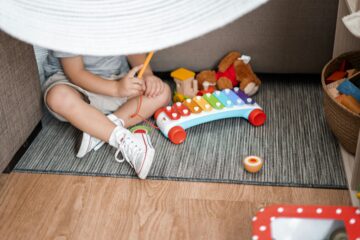“Musical instruments are the toys of the soul.” – Albert Einstein. We all know that musical toys are essential and very exclusive for child development, however choosing the right type of toys according to the child’s development stages could be a head scratcher. So let’s learn a bit more about musical toys and discover the realm of joy for your family.

Music is crucial for child development
The Benefits of Music in Child Development
Stimulating Cognitive Development
Music stimulates the brain in a variety of ways, making it an effective tool for children’s cognitive development. Kids’ interactions with musical toys stimulate a number of mental processes, such as memory, attention, pattern identification, and problem-solving abilities. Children build their auditory processing skills by experimenting with various sounds, pitches, and rhythms, which supports language and speech development.
Additionally, using musical toys teaches kids the fundamentals of arithmetic, such as counting beats and identifying patterns. As a result of these experiences, children learn to organise sounds, recognise sequences, and develop a sense of timing and rhythm, all of which provide the groundwork for mathematical reasoning.
Enhancing Fine Motor Skills
Playing musical instruments needs hand, finger, and occasionally foot coordination. Children’s hand-eye coordination and fine motor abilities are developed as they handle keys, pluck strings, or tap on drums. Their dexterity and control, which are important for a variety of tasks like writing, sketching, and self-care, are improved by these motions.
Developing Emotional Expression
Music has a significant impact on our emotions, and children are no exception. Kids can express their emotions and experiences through musical toys in a secure and convenient environment. Children may express their feelings through sound, whether they are playing a miniature guitar or hitting keys on a keyboard. They can experiment with generating various moods, such as upbeat melodies or calming music, enabling them to discover and express their inner world.
Fostering Social engagement
Children’s musical toys frequently promote teamwork and social engagement. Playing music together fosters collaboration, communication, and teamwork whether participants join a band or merely share instruments. It offers a communal experience that can bolster relationships and foster crucial social abilities. Children learn to listen to others, take turns, and value the contributions of their peers by arranging harmonies and synchronising rhythms.
Cultivating Creativity and Imagination
Musical toys give kids the inspiration they need to be imaginative and creative. Children are encouraged to engage in imaginative play by making up their own melodies, songs, and stories. Their imagination soars as they play around with various sounds and combine them in original ways. A sense of invention and artistic inquiry are encouraged by musical toys, which also promote improvisation and free expression.
When would be the best time for me to introduce musical toys to my baby?

You can introduce musical toys to your baby right from birth. “It is proven that music has a role in brain development before birth” Dr. Ibrahim Baltag stated that music ignites all areas of child development and skills for school readiness and learning to play a musical instrument can improve mathematical learning and even increase school scores. Depending on your child’s age and developmental stages, you should decide when to introduce them to musical toys. Here are some general principles to take into account:
Infants (0-6 Months)
Infants are still developing their senses and motor skills during the early infancy (0–6 month) period. Their auditory senses can be stimulated by soft-sounding musical toys like rattles or soft-chime toys. Toys that are simple to grab and manipulate will encourage the development of motor skills and hand-eye coordination.
Late Infancy (6–12 Months)
As infants become older, they start showing more interest in investigating cause-and-effect connections. Piano mats and musical mobiles are two examples of musical toys that respond to touch and can pique children’s interest in the sound-making process. To keep their interest, use toys with vivid colours, varied materials, and straightforward melodies.
Toddlers Ages (1-3 years)
Toddlers are observant and eager to learn about their surroundings. Introduce them to age-appropriate musical instruments now, including toy keyboards, xylophones, or drum sets. With the help of these toys, they can experiment with making noises and rhythms, developing their creativity and dexterity. Make sure the instruments are secure and suitable for their age while monitoring their play.
Preschool Age (3-5 Years)
Preschoolers are improving their hand-eye coordination and linguistic skills. They are capable of handling musical instruments with more intricate controls, such as toy guitars, keyboards with numerous keys, or handheld percussion instruments. By giving them musical props and props to go with their singing or storytelling, you may encourage their imaginative play.
Every child is different, and this includes their level of preparation for musical toys. When your child interact with musical toys, pay attention to their interests, attention spans, and developmental milestones. You must provide and monitor a safe atmostphere to ensure they utilise the toys responsibly and avoid any potential hazards.


